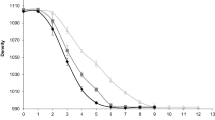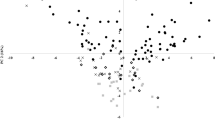Abstract
The wine industry intends to boost production of high-quality, innovative and competitive sparkling wines, since they have experienced a growth in consumption. Volatile compounds of sparkling wines produced with faster alternative methods (Ancestral and Single Tank Fermentation, STF) were compared to usual ones (Traditional and Charmat) using headspace solid-phase micro-extraction and gas chromatography with mass spectrometry detection (HS-SPME-GC/MS) followed by heat map and hierarchical grouping analysis (HCA). Esters with fruity, floral, honey and sweet characteristics were mainly responsible for the uniqueness of the sparkling wines produced by alternative methods. Five esters (isoamyl acetate, ethyl hexanoate, ethyl octanoate, 2-phenylethyl acetate and isopentyl hexanoate) were found at levels above their odour thresholds (30, 55, 580, 250 and 100 µg L−1, respectively) in the Ancestral (122.8, 152.2, 588.0, 293.1 and 120.65 µg L−1, respectively) and STF (136.8, 172.6, 599.4, 291.7 and 129.76 µg L−1, respectively) sparkling wines. In contrast, hexanol (herbaceous odour, 790.3 and 845.5 µg L−1) and isoamyl octanoate (oily odour, 159.2 and 161.7 µg L−1), which may impair the quality, were found at levels above the odour threshold (110 and 152.0 µg L−1) in the Charmat and Traditional sparkling wines, respectively. Sensory profile evaluated using quantitative descriptive analysis (QDA) showed that alternative sparkling wines were characterised by an enhanced odour of sweet, floral tropical and citrus fruit, in addition to effervescence, intensity of yellow colour, creaminess, body and taste. Therefore, Ancestral and STF resulted in desirable-quality sparkling wines that can be produced through faster processes with fewer steps.




Similar content being viewed by others
Data availability
All data included in this manuscript are available upon request by contacting the corresponding authors.
References
OIV. International Organisation of Vine and Wine (2020) The global sparkling wine market OIV Focus. 21. https://www.oiv.int/public/medias/7291/oiv-sparkling-focus-2020.pdf. Accessed 21 May 2023
Ribéreau-Gayon P, Glories Y, Maujean A, Dubourdieu D (2006) Handbook of Enology, 2nd edn. Wiley, Chichester
INAO. Institut National de L’Origine et de la Qualité (2020) Appellation d’origine protégée/contrôlée (AOP/AOC). https://www.inao.gouv.fr. Accessed 21 May 2023
Europe Commission (E.C.) (2008) Council Regulation (E.C.) N° 479/2008 of 29 April 2008 on the common organisation of the market in wine, 1–114
Ubeda C, Kania-Zelada I, del Barrio-Galán R, Medel-Marabolí M, Gil M, Peña-Neira A (2019) Study of the changes in volatile compounds, aroma and sensory attributes during the production process of sparkling wine by traditional method. Food Res Int 119:554–563. https://doi.org/10.1016/j.foodres.2018.10.032
Caliari V, Panceri CP, Rosier JP, Bordignon-Luiz MT (2015) Effect of the traditional, charmat and asti method production on the volatile composition of moscato giallo sparkling wines. LWT Food Sci Technol 61:393–400. https://doi.org/10.1016/j.lwt.2014.11.039
Soares RD, Welke JE, Nicolli KP, Zanus M, Caramã EB, Manfroi V, Zini CA (2015) Monitoring the evolution of volatile compounds using gas chromatography during the stages of production of Moscatel sparkling wine. Food Chem 183:291–304. https://doi.org/10.1016/j.foodchem.2015.03.013
Martínez-García R, García-Martínez T, Puig-Pujol A, Mauricio JC, Moreno J (2017) Changes in sparkling wine aroma during the second fermentation under CO2 pressure in sealed bottle. Food Chem 237:1030–1040. https://doi.org/10.1016/j.foodchem.2017.06.066
Di Gianvito P, Perpetuini G, Tittarelli F, Schirone M, Arfelli G, Piva A, Patrignani F, Lanciotti R, Olivastri L, Suzzi G, Tofalo R (2018) Impact of Saccharomyces cerevisiae strains on traditional sparkling wines production. Food Res Int 109:552–560. https://doi.org/10.1016/j.foodres.2018.04.070
Welke JE, Dachery B, Dal Magro L, Hernandes KC, Zini CA (2022) Volatile compounds formation in sparkling wine. CRC Press, Boca Raton
Boatto V, Pomarici ELB (2018) Conegliano Valdobbiadene Prosecco PDO’s Wine Market - Annual Report 2018. https://www.prosecco.it. Accessed 21 May 2023
Benoît L, William A, Lindsey H, Adrienne LF, Marianne MW (2018) Wine sector: Definitions and nuances from global to country analysis-A comparison between old world, new world, and emerging wine countries from 2005 to current. Elsevier, Duxford
del González-Jiménez MC, Moreno-García J, García-Martínez T, Moreno JJ, Puig-Pujol A, Capdevilla F, Mauricio JC (2020) Differential analysis of proteins involved in ester metabolism in two Saccharomyces cerevisiae strains during the second fermentation in sparkling wine elaboration. Microorganisms 8:403. https://doi.org/10.3390/microorganisms8030403
Ubeda C, Callejón RM, Troncoso AM, Peña-Neira A, Morales ML (2016) Volatile profile characterisation of Chilean sparkling wines produced by traditional and Charmat methods via sequential stir bar sorptive extraction. Food Chem 207:261–271. https://doi.org/10.1016/j.foodchem.2016.03.117
Brasil. Ministério da Agricultura Pecuária e do Abastecimento (2014) Decreto No 8.198, de 20 de fevereiro de 2014. https://www.planalto.gov.br/ccivil_03/_ato2011-2014/2014/decreto/d8198.htm. Accessed 21 May 2023
Laffort (2019) Catalog. https://laffort.com/en/catalogs. Accessed 21 May 2023
Lallemand (2020) Catalogue Lallemand Enologia. https://www.lallemandwine.com. Accessed 21 May 2023
Flanzy C (2003) Enología: Fundamentos científicos y tecnológicos, 2nd edn. Ediciones Mundi-Prensa, Madrid
OIV. International Organisation of Vine and Wine (2021) International Code Of Oenological Practices. https://www.oiv.int/public/medias/7713/en-oiv-code-2021.pdf. Accessed 21 May 2023
OIV. International Organisation of Vine and Wine (2021) Compendium of International Methods of Wine and Must Analysis. https://www.oiv.int/public/medias/7907/oiv-vol1-compendium-of-international-methods-of-analysis.pdf. Accessed 21 May 2023
ICH. International Conference on Harmonisation (2005) Validation of Analytical Procedures. https://database.ich.org. Accessed 20 May 2023
Moskowitz HR (1983) Product testing and sensory evaluation of foods: marketing and R and d approaches. Food & Nutrition Press, Westport
Brasil. Conselho Nacional de Saúde (2012) Resolução n° 466, de 12 de dezembro de 2012, Brasília. http://saudelegis.saude.gov.br/saudelegis/secure/norma/listPublic.xhtml. Accessed 19 May 2023
Brasil. Ministério da Agricultura Pecuária e do Abastecimento (2019) Regras gerais sobre o padrão de identidade e qualidade das bebidas, fermentado acético, vinho e derivados de uva e do vinho importados, Brasília. http://sistemasweb.agricultura.gov.br/sislegis/action/detalhaAto.do?method=abreLegislacaoFederal&chave=50674&tipoLegis=A. Accessed 15 May 2023
BRASIL. Ministério da Agricultura Pecuária e do Abastecimento (2004) Lei No 10.970, de 12 de novembro de 2004, Brasília. http://sistemasweb.agricultura.gov.br/sislegis/action/detalhaAto.do?method=abreLegislacaoFederal&chave=50674&tipoLegis=A. Accessed 15 May 2023
Tufariello M, Pati S, D’Amico L, Bleve G, Losito I, Grieco F (2019) Quantitative issues related to the headspace-SPME-GC/MS analysis of volatile compounds in wines: the case of Maresco sparkling wine. LWT Food Sci Technol 108:268–276. https://doi.org/10.1016/j.lwt.2019.03.063
AOAC International (2016) Appendix F: Guidelines for Standard Method Performance Requirements. AOAC Int Off Method Anal, Rockville. https://www.aoac.org. Accessed 15 May 2023
Korenika AMJ, Preiner D, Tomaz I, Jeromel A (2020) Volatile profile characterization of croatian commercial sparkling wines. Molecules 25:4349. https://doi.org/10.3390/molecules25184349
Stoica F, Muntean C, BăducăCîmpeanu C, Giurgiulescu L (2017) Influence of clarification treatment on oenological and quality characteristics on young white wine sauvignon. Carpathian J Food Sci Technol 9:112–118
Jeromel A, Korenika AMJ, Tomaz I (2019) An influence of different yeast species on wine aroma composition, 1st edn. Elsevier, Cambridge
López de Lerma N, Peinado RA, Puig-Pujol A, Mauricio JC, Moreno J, García-Martínez T (2018) Influence of two yeast strains in free, bioimmobilized or immobilized with alginate forms on the aromatic profile of long aged sparkling wines. Food Chem 250:22–29. https://doi.org/10.1016/j.foodchem.2018.01.036
Welke JE, Zanus M, Lazzarotto M, Pulgati FH, Zini CA (2014) Main differences between volatiles of sparkling and base wines accessed through comprehensive two dimensional gas chromatography with time-of-flight mass spectrometric detection and chemometric tools. Food Chem 164:427–437. https://doi.org/10.1016/j.foodchem.2014.05.025
Di Gianvito P, Arfelli G, Suzzi G, Tofalo R (2019) New trends in sparkling wine production: yeast rational selection, 1st edn. Elsevier, Cambridge
Nicolli KP, Welke JE, Closs M, Caramão EB, Costa G, Manfroi V, Zini CA (2015) Characterization of the Volatile Profile of Brazilian Moscatel Sparkling Wines Through Solid Phase Microextraction and Gas Chromatography. J Braz Chem Soc. 26:1411–1430. https://doi.org/10.5935/0103-5053.20150110
Kemp B, Condé B, Jégou S, Howell K, Vasserot Y, Marchal R (2018) Chemical compounds and mechanisms involved in the formation and stabilization of foam in sparkling wines. Crit Rev Food Sci Nutr 59:2072–2094. https://doi.org/10.1080/10408398.2018.1437535
Vecchio R, Lisanti MT, Caracciolo F, Cembalo L, Gambuti A, Moio L, Siani T, Marotta G, Nazzaro C, Piombino P (2019) The role of production process and information on quality expectations and perceptions of sparkling wines. J Sci Food Agric 99:124–135. https://doi.org/10.1002/jsfa.9153
Cisilotto B, Scariot FJ, Schwarz LV, Mattos Rocha RK, Longaray Delamare AP, Echeverrigaray S (2023) Are the characteristics of sparkling wines obtained by the Traditional or Charmat methods quite different from each other? OENO One 57:321–331. https://doi.org/10.20870/oeno-one.2023.57.1.7313
Tofalo R, Perpetuini G, Rossetti AP, Gaggiotti S, Piva A, Olivastri L, Cichelli A, Compagnone D, Arfelli G (2022) Impact of Saccharomyces cerevisiae and non-Saccharomyces yeasts to improve traditional sparkling wines production. Food Microbiol 108:104097. https://doi.org/10.1016/j.fm.2022.104097
Funding
This study was funded by the National Council of Technological and Scientific Development (Conselho Nacional de Desenvolvimento Científico e Tecnológico, project 408625/2016-3), the Coordination for the Improvement of Higher Education Personnel (Coordenação de Aperfeiçoamento de Pessoal de Nível Superior, CAPES) and Research Support Foundation of Rio Grande do Sul (Fundação de Amparo à Pesquisa do Estado do Rio Grande do Sul, FAPERGS, PQG 19/2551-0001855-0).
Author information
Authors and Affiliations
Corresponding author
Ethics declarations
Conflict of interest
The authors declare that they have no conflict of interest.
Ethical approval
The sensory analysis procedure in this study was approved by the Research Ethics Committee (CAAE 28739120.9.0000.5347), in accordance with Resolution 466/12, of the National Health Council, Brazil.
Additional information
Publisher's Note
Springer Nature remains neutral with regard to jurisdictional claims in published maps and institutional affiliations.
Supplementary Information
Below is the link to the electronic supplementary material.
Rights and permissions
Springer Nature or its licensor (e.g. a society or other partner) holds exclusive rights to this article under a publishing agreement with the author(s) or other rightsholder(s); author self-archiving of the accepted manuscript version of this article is solely governed by the terms of such publishing agreement and applicable law.
About this article
Cite this article
Dachery, B., Hernandes, K.C., Zini, C.A. et al. Volatile and sensory profile of sparkling wines produced by faster and alternative methods (Ancestral and Single Tank Fermentation) compared to the usual methods (Charmat and Traditional). Eur Food Res Technol 249, 2363–2376 (2023). https://doi.org/10.1007/s00217-023-04303-z
Received:
Revised:
Accepted:
Published:
Issue Date:
DOI: https://doi.org/10.1007/s00217-023-04303-z




